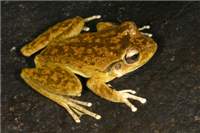Family
HylidaeGenus
LitoriaSpecies
lesueuriThreats/Control Methods - Regional
Broad scale threatening processes include habitat modification, the introduction of feral flora and fauna and, possibly, the Chytrid fungus which has been found in some members of the species. For more information on the Chytrid fungus © Link to fact sheet http://www.deh.gov.au/biodiversity/invasive/publications/c-disease/
To prevent the spread of the Chytrid fungus it is important to wash your shoes before entering and after leaving frog habitats.
Frogs drink and breathe through their skin and are very sensitive to chemicals in their environment. Where possible, you should not handle frogs, as the natural bacteria on your hands or chemicals such as sunscreen can damage their skin and cause illness or death.
Local/Urban Actions
There is no action specifically aimed at the species. General monitoring of frog populations in the ACT is done yearly through the Frogwatch Program. The Frogwatch program provides training for community volunteers each October, with monitoring then being undertaken by volunteers over a two week period.For more information on Frogwatch contact: The ACT Frogwatch Coordinator, Ginninderra Catchment Group; Ph(02)62783309 or email: [email protected]
It is also possible to promote urban backyards to frogs as suitable habitat, through simple landscaping techniques. The Australian National University and the Ginninderra Catchment Group have developed a guideline to help you encourage frogs into your backyard called [Link - Creating a Frog Friendly Habitat in the ACT Community]
Distinguishing Features
A yellow to brown frog, with darker blotches sometimes found on the back. A distinctive solid black stripe runs from the nose, through the eye, to the tympanum, after which the stripe breaks up. Similar to the Broad-Palmed Frog (Litoria latopalmata), Peron©s Tree Frog (Litoria peroni) and the Whistling Tree Frog (Litoria verreauxii verreauxii) in appearance. The species can be by the pointier head shape, the presence of black-purple markings on the thigh, in Litoria latopalmata the thigh has a distinctive yellow and black net-like marking and in Litoria verreauxii© the thigh is yellow-red, and a horizontal pupil in Litoria lesueuri, Litoria peronii has a distinctive cross-shaped iris, although the easiest method to identify the species is by call. This species has a quite call that can be difficult to hear even from short distances. When audible the call is described as a creww crewwk crewwwwk crewwwwwk.
Common name/s
Rocky Stream Frog, Leseur©s Frog, Stony-creek Frog
Similar Species
Green and Golden Bell Frog (Litoria auera), Booroolong Frog (Litoria booroolongensis), Tablelands Bell Frog (Litoria castenea), Broad-palmed Frog (Litoria latopalmata), Southern Leaf-Green Tree Frog (Litoria nudidigitus), Peron©s Tree Frog (Litoria peronii), Southern Bell Frog (Litoria raniformis), Spotted Tree Frog (Litoria spenceri), Whistling Tree Frog (Litoria verreauxii verreauxii).
Distribution
Low-land streams throughout Eastern Australia. Along Eastern Australia from Queensland through to Victoria.
Country of Origin
Australia
Survey Techniques
By far the easiest and safest, for both yourself and frogs, is call identification.
Conservation (Pet/Pest) Status - National
Not currently thought to be under threat although small population declines have been noted.
Conservation (Pet/Pest) Status - Regional
Not currently thought to be under threat although small population declines have been noted.
Associated Vegetation Community
Found across a wide variety of habitats including coastal heathlands, dry sclerophyll forests, rainforests and large dams.
Limiting Resources
Tadpoles prefer shallow water aquatic debris for shelter. Occurs at altitudes from 40-1100m.
Breeding
Breeding occurs in spring, when the species lays its eggs under rock in shallow pools. Calls from November- December.
Behaviour
The species will quickly jump away from terrestrial predators, often expelling impressive amounts of urine.
Functional Group
Insectivore
Food Species
Small invertebrates.
Predators
The introduced trout (Salmo trutta) has been known to predate upon tadpoles.
Interesting Fact
The quiet nature of this frog©s call, when compared to the calls of other frogs, is due to the absence of a vocal sac (also absent inL. booroolongensis) in this species, not allowing for the amplification and projection of call found in other species who have sacs , such as thte Spotted Grass Frog (L. tasmanensis).
References - (reader suitability of references, P=Primary teachers, S=Secondary students, T=Tertiary students and researchers)
Journals:
Antis,M. et al. (1998.) Breeding biology of Litoria booroolongensis ( Moore, 1961) and Litoria lesueuri (Dum©ril & Bibron, 1841) (Anura: Hylidae) and comments on population declines of L.booroolongensis. Transactions of the Royal Society of South Australia Incorporated. 122: 33-44. T
Gillespie, G. (2001). The role of introduced trout in the decline of the spotted tree frog (Litoria spenceri) in south-eastern Australia. Biological Conservation.100:187-198. T
Books:
Turner, J. (2004). Frogs of Australia: An Introduction to their Classification, Biology and Distribution. Pensoft. Bulgaria.S,T
Tyler, M. (1994). Australian Frogs; a natural history. Reed New Holland. Sydney, Australia. S,T
Online Publications:
Woodhams, D. (2001.). Litoria lesueuri. James Cook University. Accessed 6 July 2006. Available online:
http://www.jcu.edu.au/school/tbiol/zoology/herp/Litorialesueuri.PDF_ P,S
Frogs Australia Network. Litoria lesueuri. Accessed 1July2006. Available online:
http://frogsaustralia.net.au/frogs/display.cfm?frog_id=161 P,S
Amphibian Research Centre. Litoria lesueuri. Accessed 1July 2006. Available online: http://frogs.org.au/frogs/species/Litoria/lesueuri/ P,S
Researcher: Pippa Jaminon



 Top
Top Top
Top